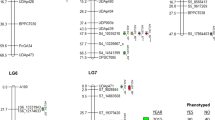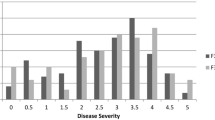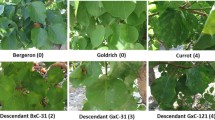Abstract
Leprosis, caused by citrus leprosis virus (CiLV) and transmitted by the tenuipalpid mite Brevipalpus phoenicis, is one of the most important viruses of citrus in the Americas. Sweet oranges (Citrus sinensis L. Osb.) are highly susceptible to CiLV, while mandarins (C. reticulata Blanco) and some of their hybrids have higher tolerance or resistance to this disease. The mechanisms involved in the resistance and its inheritance are still largely unknown. To study the quantitative trait loci (QTL; quantitative trait loci) associated with the resistance to CiLV, progeny analyses were established with 143 hybrid individuals of ‘Pêra’ sweet orange (C. sinensis L. Osb.) and ‘Murcott’ tangor (C. reticulata Blanco × C. sinensis L. Osb.) from controlled crossings. Disease assessment of the hybrid individuals was conducted by infesting the plants with viruliferous mites in the field. The experiment consisted of a randomized completely block design with ten replicates. The evaluated phenotypic traits were incidence and severity of the disease on leaves and branches, for a period of 3 years. The MapQTL™ v.4.0 software was used for the identification and location of possible QTL associated with resistance to CiLV on a genetic map obtained from 260 AFLP and 5 RAPD markers. Only consistent QTLs from different phenotypic traits and years of evaluation, with the critical LOD scores to determine the presence or absence of each QTL calculated through the random permutation test, were considered. A QTL was observed and had a significant effect on the phenotypic variation, ranging from 79.4 to 84% depending on which trait (incidence or severity) was assessed. This suggests that few genes are involved in the genetic resistance of citrus to CiLV.



Similar content being viewed by others
References
Araújo EF, Queiróz LP, Machado MA (2003) What is Citrus? Taxonomic implications from a study of cp-DNA evolution in the tribe Citreae (Rutaceae subfamily Aurantioideae). Org Divers Evol 3:55–62. doi:10.1078/1439-6092-00058
Asíns MJ, Bernet GP, Ruiz C et al (2004) QTL analysis of Citrus tristeza virus-citradia interaction. Theor Appl Genet 108:603–611. doi:10.1007/s00122-003-1486-7
Barret HC, Rhodes AM (1976) A numerical study of affinity relationships in cultivated Citrus and its close relatives. Syst Bot 1:105–136. doi:10.2307/2418763
Bassanezi RB, Laranjeira FF (2007) Spatial patterns of leprosis and its mite vector in commercial citrus groves in Brasil. Plant Pathol 56:97–106. doi:10.1111/j.1365-3059.2006.01457.x
Bastianel M, Freitas-Astua J, Kitajima EW et al (2006a) The citrus leprosis pathosystem. Summa Phytopathol 32:211–220. doi:10.1590/S0100-54052006000300001
Bastianel M, Oliveira AC, Cristofani M, Guerreiro Filho O et al (2006b) Inheritance and heritability of resistance to citrus leprosis. Phytopathology 96:1092–1096. doi:10.1094/PHYTO-96-1092
Bastianel M, Freitas-Astúa J, Nicolini F et al (2008) Response of mandarin cultivars and hybrids to citrus leprosis vírus. J Plant Pathol 90:305–310
Bernet GP, Margaiz C, Jacas J et al (2005) Genetic analysis of citrus leafminer susceptibility. Theor Appl Genet 110:1393–1400. doi:10.1007/s00122-005-1943-6
Bitancourt AA (1955) Estudos sobre a leprose dos citros. Arq Inst Biol (Sao Paulo) 22:161–203
Cai Q, Guy CL, Moore GA (1994) Extension of the linkage map in citrus using random amplified polymorphic DNA e RFLP mapping of cold acclimation-responsive loci. Theor Appl Genet 89:606–614. doi:10.1007/BF00222455
Chen C, Zhou P, Choi YA et al (2006) Mining and characterizing from citrus ESTs. Theor Appl Genet 112:1248–1257. doi:10.1007/s00122-006-0226-1
Chen C, Bowman KD, Choi YA et al (2008) EST-SSR genetic maps for Citrus sinensis and Poncirus trifoliata. Tree Genet Genomes 4:1–10. doi:10.1007/s11295-007-0083-3
Childers CC, Rodrigues JCV, Derrick KS et al (2003a) Citrus leprosis and its status in Florida and Texas: past and present. Exp Appl Acarol 30:181–202. doi:10.1023/B:APPA.0000006548.01625.72
Childers CC, Rodrigues JCV, Welbourn WC (2003b) Host plants of Brevipalpus californicus, B. obovatus, and B. phoenicis (Acari: Tenuipalpidae) and their potential involvement in the spread of one or more viral diseases vectored by these mites. Exp Appl Acarol 30:29–105. doi:10.1023/B:APPA.0000006544.10072.01
Churchill GA, Dodge RW (1994) Empirical threshold values for quantitative values for quantitative trait mapping. Genetics 138:963–971
Cristofani M, Machado MA, Grattapaglia D (1999) Genetic linkage maps of Citrus sunki Hort. Ex. Tan. and Poncirus trifoliata (L.) Raf. and mapping of citrus tristeza virus resistance gene. Euphytica 109:25–32. doi:10.1023/A:1003637116745
Freitas-Astúa J, Bastianel M, Locali-Fabris EC et al (2007) Differentially expressed stress-related genes in the compatible citrus–citrus leprosis virus interaction. Genet Mol Biol 30:980–1018. doi:10.1590/S1415-47572007000500026
Garcia AAF, Kido EA, Meza AN et al (2006) Development of an integrated genetic map of a sugarcane (Saccharum spp.) commercial cross, based on a maximum-likelihood approach for estimation of linkage and linkage phases. Theor Appl Genet 112:298–314. doi:10.1007/s00122-005-0129-6
Kitajima EW, Müller GW, Costa AS et al (1974) Short, rod-like particles associated with citrus leprosis. Virology 50:254–258. doi:10.1016/0042-6822(72)90366-2
Knorr LC (1968) Studies on the etiology of leprosis in citrus. In Conference of the International Organization of Citrus Virologists 4:332–341
Kosambi DD (1944) The estimation of map distance from recombination values. Ann Eugen 12:172–175
Ling P, Duncam LW, Deng Z et al (2000) Inheritance of citrus nematode resistance and its linkage with molecular markers. Theor Appl Genet 100:1010–1017. doi:10.1007/s001220051382
Litt M, Luty JA (1989) A hypervariable microsatellite revealed by in vitro amplification of a dinucleotide repeat within the cardiac muscle actin gene. Am J Hum Genet 44:398–401
Locali EC, Freitas-Astúa J, Souza AA et al (2003) Development of a molecular tool for the diagnosis of leprosis, a major threat to citrus production in the Americas. Plant Dis 87:1317–1321. doi:10.1094/PDIS.2003.87.11.1317
Locali-Fabris EC, Freitas-Astúa J, Souza AA et al (2006) Complete nucleotide sequence, genomic organization and phylogenetic analysis of citrus leprosis virus cytoplasmic type (CiLV-C). J Gen Virol 87:2721–2729. doi:10.1099/vir.0.82038-0
Luro F, Lorieux M, Laigret F et al (1994) Genetic mapping of an intergeneric Citrus hybrid using molecular markers. Fruits 49:404–408
Machado MA, Coletta Filho HD, Targon MLNP et al (1996) Genetic relationship of mediterranean mandarins (Citrus deliciosa Tenore) using RAPD markers. Euphytica 92:321–326. doi:10.1007/BF00037115
Maliepaard C, Van Ooijen JW (1994) QTL mapping in a full-sib family of an outcrossing species. In: Van Ooijen JW, Jansen J (eds) Biometrics in plant breeding: applications of molecular markers, Proceedings of the ninth meeting of the EUCARPIA section biometrics in plant breeding, 6–8 July 1994, Wageningen, The Netherlands, pp 140–146
Maliepaard C, Jansen J, Van Ooijen JW (1997) Linkage analysis in a full-sib family of an outbreeding plant species: overview and consequences for applications. Genet Res 70:237–250. doi:10.1017/S0016672397003005
Maliepaard C, Alston FH, Van Arkel G et al (1998) Aligning male and female linkage maps of apple (Malus pumila Mill.) using multi-allelic markers. Theor Appl Genet 97:60–73. doi:10.1007/s001220050867
Marques JPR, Freitas-Astúa J, Kitajima EW et al (2007) Lesões foliares e de ramos de laranjeira-doce causadas pela leprose-dos-citros. Pesq agropec bras 42:1531–1536
Mussumeci MR, Rosseti V (1963) Transmissão dos sintomas da leprose dos citros pelo acaro Brevipalpus phoenicis. Cienc Cult 15:228
Oliveira AC, Novelli VM, Garcia NA et al (2000) Identification of sexual and nucellar Citrus seedlings through single and duplex PCR of simple sequence repeat locus. Proc Intl Soc Citriculture pp 3:8–141
Oliveira AC, Novelli VM, Garcia NA et al (2002) Identification of citrus hybrids through the combination of a leaf apex morphology and SSR markers. Euphytica 128:397–403. doi:10.1023/A:1021223309212
Oliveira AC, Bastianel M, Cristofani-Yali M et al (2007) Development of genetic maps of the citrus varieties Murcott tangor and Pêra sweet orange by using fluorescent AFLP markers. J Appl Genet 48:219–231
Palmieri DA, Novelli VM, Bastianel M et al (2007) Frequency and distribution of microsatellites from ESTs of citrus. Genet Mol Biol 30:1009–1018. doi:10.1590/S1415-47572007000500029
Powell W, Morgante M, Andre C et al (1996) The comparison of RFLP, RAPD, AFLP AND SSR (microsatellites) markers for germoplasm analysis. Mol Breed 2:225–238. doi:10.1007/BF00564200
Rao MN, Soneji JR, Chen C et al (2008) Characterization of zygotic and nucellar seedlings from sour orange-like citrus rootstock candidates using RAPD and EST-SSR markers. Tree Genet Genomes 4:113–124
Rodrigues JCV (2000) Relações patógeno-vetor-planta no sistema leprose dos citros. PhD Dissertation, Universidade de São Paulo, Piracicaba, SP, 168 pp
Rodrigues JCV, Muller GW, Nogueira NL et al (2000) Yield damage associated to citrus leprosis on sweet-orange varieties. Proc Intl Soc Citriculture pp 105:5–1059
Rodrigues JCV, Nogueira NL, Machado MA (2002) Elaboração e validação de escala diagramática para leprose dos citros. Summa Phytopathol 28:192–196
Rodrigues JCV, Kitajima EW, Childers CC et al (2003) Citrus leprosis virus vectored by Brevipalpus phoenicis (Acari: Tenuipalpidae) on citrus in Brazil. Exp Appl Acarol 30:161–179. doi:10.1023/B:APPA.0000006547.76802.6e
Saliba-Colombani V, Causse M, Gervais L et al (2000) Efficiency of RFLP, RAPD, and AFLP markers for the construction of an intraespecific map of the tomato genome. Genome 43:29–40. doi:10.1139/gen-43-1-29
Siviero A, Cristofani M, Furtado EL et al (2006) Identification of QTLs associated with citrus resistance to Phytophthora gummosis. J Appl Genet 47:23–28
Van Ooijen JW, Voorrips RE (2001) JoinMap® version 3.0, software for the calculation of genetic linkage maps. Plant Research International, Wageningen
Van Ooijen JW, Boer MP, Jansen RC (2002) MapQTL®4, software for the calculation of QTL positions on genetic maps. Plant Research International, Wageningen
Vergani AR (1945) Transmission y naturaleza de la “lepra explosiva” del naranjo. Ministerio de Agricultura de la Nación. Buenos Aires. Instituto Sanidad Vegetal. Ser A. 5:1–11
Willians JGK, Kubelik AR, Livak KJ et al (1990) DNA polymorphisms amplified by arbitrary primers are useful as genetic markers. Nucleic Acids Res 18:7213–7218. doi:10.1093/nar/18.24.7213
Wu R, Ma CX (2002) Simultaneous maximum likelihood estimation of linkage and linkage phase in outcrossing species. Theor Popul Biol 61:349–363. doi:10.1006/tpbi.2002.1577
Acknowledgments
We thank N. Nogueira (CENA/USP) for providing the initial source of inoculum of CiLV-C and J. C. V. Rodrigues (Universidad de Puerto Rico), E. W. Kitajima (ESALQ/USP), and R. B. Bassanezi (Fundecitrus) for their suggestion and help setting up the experiments. This work was partially funded by CNPq (Pronex and Millennium Institute) and Fapesp (Proc. 01/8181-7 and 04/10511-3).
Author information
Authors and Affiliations
Corresponding author
Rights and permissions
About this article
Cite this article
Bastianel, M., Cristofani-Yaly, M., de Oliveira, A.C. et al. Quantitative trait loci analysis of citrus leprosis resistance in an interspecific backcross family of (Citrus reticulata Blanco × C. sinensis L. Osbeck) × C. sinensis L. Osb. Euphytica 169, 101–111 (2009). https://doi.org/10.1007/s10681-009-9950-3
Received:
Accepted:
Published:
Issue Date:
DOI: https://doi.org/10.1007/s10681-009-9950-3




